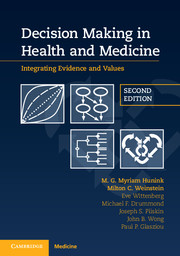Book contents
- Frontmatter
- Dedication
- Contents
- Foreword
- Foreword to the first edition (2001)
- Preface
- Acknowledgments
- list of Abbreviations
- About the authors
- 1 Elements of decision making in health care
- 2 Managing uncertainty
- 3 Choosing the best treatment
- 4 Valuing outcomes
- 5 Interpreting diagnostic information
- 6 Deciding when to test
- 7 Multiple test results
- 8 Finding and summarizing the evidence
- 9 Constrained resources
- 10 Recurring events
- 11 Estimation, calibration, and validation
- 12 Heterogeneity and uncertainty
- 13 Psychology of judgment and choice
- Index
- References
7 - Multiple test results
Published online by Cambridge University Press: 05 October 2014
- Frontmatter
- Dedication
- Contents
- Foreword
- Foreword to the first edition (2001)
- Preface
- Acknowledgments
- list of Abbreviations
- About the authors
- 1 Elements of decision making in health care
- 2 Managing uncertainty
- 3 Choosing the best treatment
- 4 Valuing outcomes
- 5 Interpreting diagnostic information
- 6 Deciding when to test
- 7 Multiple test results
- 8 Finding and summarizing the evidence
- 9 Constrained resources
- 10 Recurring events
- 11 Estimation, calibration, and validation
- 12 Heterogeneity and uncertainty
- 13 Psychology of judgment and choice
- Index
- References
Summary
Even though the diagnostic radiologist examines black-and-white images, the information that is derived from the images is hardly ever black-and-white.
M.G. Myriam HuninkIntroduction
In the previous chapters we focused on dichotomous test results, e.g., fecal occult blood is either present or absent. Test results can conveniently be dichotomized, and thinking in terms of dichotomous test results is generally helpful. Distinguishing patients with and without the target disease is useful for the purpose of subsequent decision making because most medical actions are dichotomous. In reality, however, most test results have more than two possible outcomes. Test results can be categorical, ordinal, or continuous. For example, categories of a diagnostic imaging test may be defined by key findings on the images. These categories may be ordered (intuitively) according to the observer’s confidence in the diagnosis, based on the findings. As an example, abnormalities seen on mammography are commonly reported as definitely malignant, probably malignant, possibly malignant, probably benign, or definitely benign. As we shall see later in this chapter, it makes sense to order the categories (explicitly) according to increasing likelihood ratio (LR). Some test results are inherently ordinal, e.g., the five categories of a Papanicolaou smear (test for cervical cancer) are ordinal. Results of biochemical tests are usually given on a continuous scale, which may be reduced to an ordinal scale by grouping the test results. Thus, a test result on a continuous scale can be considered a result on an ordinal scale with an infinite number of very narrow categories. Scores from prediction models are on an ordinal scale if there are a finite number of possible scores, and on a continuous scale if there are an infinite number of scores. When test results are categorical, ordinal, or continuous, we have to consider many test results Ri, where i can be any value from two (the case we have considered in Chapter 5 and Chapter 6, T+ and T−) up to any number of categories. Interpretation of a test result on an ordinal scale can be considered a generalization of the situation of dichotomous test results.
- Type
- Chapter
- Information
- Decision Making in Health and MedicineIntegrating Evidence and Values, pp. 165 - 208Publisher: Cambridge University PressPrint publication year: 2014



